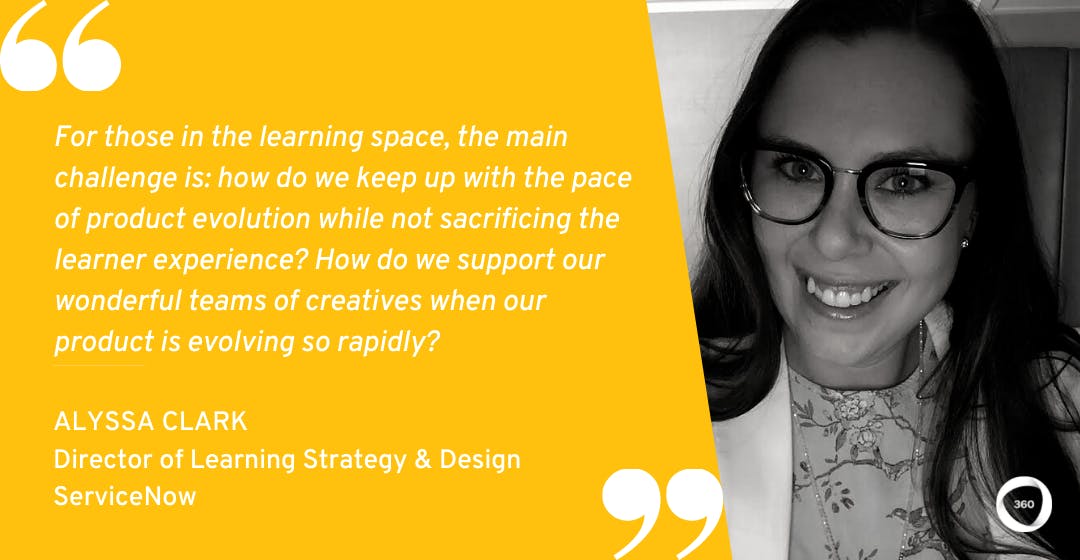As L&D leaders, we’re tasked with supporting growth and scaling by giving sales reps the resources and training they need to connect more new customers with your product.
Getting this right takes the right learning content, tools, and expert knowledge. But more than that, it takes compelling product stories to build sales rep confidence.
Recently, I had the chance to speak to a product story expert: Alyssa Clark, Director of Learning Strategy and Design at workflow platform ServiceNow. Alyssa broke down her three-step playbook for enabling sales reps with compelling product stories.
We got started with a discussion of one crucial tool many of us don’t even know we need.
Psst: Cool things are happening! Join our waitlist for the CLO Connect community, coming soon.
Why workflow management is so crucial in our remote world
ServiceNow is one of the world’s leading workflow platforms–and in the age of remote work, it’s making a big impact for users everywhere.
“ServiceNow started with IT service management,” says Alyssa. “We offer cloud-based technology that helps make the world of work better for people. We’re solving workflow challenges like ticketing systems, and offering a smoother experience with people’s day-to-day jobs.”
As Alyssa explains, this offering has changed a lot in the last two years. “We’ve evolved quickly from just the IT space to the employee experience space, and to the creator space, and the customer space. Now, we offer a range of different products, applications, and workflows that help our customers solve holistic business challenges.”
“In the wake of the last two years, we’re offering a real digital transformation solution, and we’re helping companies to get comfortable with the idea of remote working. We’ve had quite an explosion in terms of not just our product itself growing, but the need for workflow products in the market.”
So, how is Alyssa responding to the L&D challenges of ServiceNow’s rapidly evolving product?
Related: Now Is Our Only Chance to Fix Remote Work–Here’s How We’re Doing It
We’ve had quite an explosion in terms of not just our product itself growing, but the need for workflow products in the market.
The L&D challenge of keeping up with ServiceNow’s rapidly evolving product
For ServiceNow, the growing global demand for workflow solutions has been fantastic. But for Alyssa and her team, it also creates some big challenges.
“For those in the learning space, the main challenge is: how do we keep up with the pace of product evolution while not sacrificing on the learner experience or on the quality of our material? Also, as learning professionals, how do we support our wonderful teams of creatives to go out and solve these challenges when the pace of our product is evolving so rapidly?”

Alyssa was happy to break down what this means in practice. “At ServiceNow, we have releases of updates to our existing products, and also the launch of new applications and features. Traditionally, we’ve had our family release twice a year, typically in March and September. These can have anywhere from five updates to 500 updates.”
“Now, we also have monthly releases to make sure we’re offering customers the best solutions from our wonderful and brilliant engineers as quickly as possible. Keeping up with that pace has been our most significant challenge.”
Fortunately, Alyssa and her team have a playbook.
Related: Klaviyo’s 3 Steps to Driving 85%+ NPS for New Hire Enablement
ServiceNow’s 3-step playbook for telling great product stories
As Alyssa explains, keeping up with this rapidly-evolving product takes a three-step approach to telling great product stories.
First up, build your team’s familiarity with your product.
1. Build team familiarity with your product
“For me, the cornerstone of any win is the team,” says Alyssa. “I really believe that the people behind the content and the experience are the ones who truly get it done. For us, the organization and the mindset of our team is crucial to meeting this challenge.”
“We’ve drawn from an Agile approach to position ourselves as designers and creatives, and to build relationships with our product teams. We also need our product team to see us as their personal retained enablement person. This takes a deep familiarity with our product.”
2. Establish L&D as a key business partner
“We’re not just L&D people. We’re ServiceNow’s business and product experts. That credibility and alignment has been incredibly important, and the go-to-market arm of my team has really been a key business partner. We want to understand the pulse of the business.”
For Alyssa, this means asking tough questions. “Where is a product in control of go-to-market before it graduates to actual customer testing and customer feedback? We need to be intimate with our products, and we need to watch it incubate from idea to full-fledged concept.”
3. Use your product updates to tell a larger compelling story
Then, with this product familiarity in place, Alyssa and her team creates larger compelling product stories. “We’re really thinking about storytelling. We really stay true to our main workflows when we tell anecdotes to the market. We tether our ad hoc release updates–whether it’s for a small app or a feature–to our larger story.”
“Then, we shape our content to fit the context of the update and the impact on our customers. We might play with different modalities, for example, self-directed eLearning, supplemental podcasts or white papers, and some infographics.”
As Alyssa explains, this takes the right focus on bite-sized learning. “We know that our teams don’t always have time to go through even a seven or eight-minute eLearning–instead, they need something quick on their screen while they talk to customers about how the new release or update impacts their current solution.”
“The key goal is to make sure our salespeople have the resources they need to answer any customer question. We think about our use cases: how, when, and where are our customers going to need this information? This way, our designers can get a holistic view of the story we’re telling, and how this story matches our customer needs.”
For Alyssa, this approach is already making a big impact.
Related: How Drift Merges Marketing and L&D to Create ‘Curious Learning Machines’
We’re really thinking about storytelling. We really stay true to our main workflows when we tell anecdotes to the market. We tether our ad hoc release updates–whether it’s for a small app or a feature–to our larger story.
Making a big impact with learner confidence and peer engagement
As Alyssa explains, she and her team wanted to go beyond simple learning consumption metrics when discussing the impact of their training.
“Consumption was pretty much everything our product people and our internal stakeholders wanted to talk about,” says Alyssa. “We were looking at results in terms of, ‘release enablement was 90% consumed in this particular sales team’, or ‘regionally, we had 98% consumption of this group of content for the September release’. This kind of focus on consumption is great, because as L&D people we want to know people are eager to engage with our content.”
“However, my team and I weren’t satisfied with just tracking consumption metrics. We wanted to focus on metrics that can tell us whether people actually feel more confident as a result of our efforts.”
To achieve this, Alyssa focused on two important learning metrics: expressions of confidence, and peer engagement.
1. Measuring expressions of confidence
“We tethered our results to expressions of confidence from an adult learning theory perspective, because this shows us that we’re supporting individual performance by helping people to feel more confident. This is an intrinsic motivator for people.”
“This is especially important when we’re releasing a new product, because there’s a lot of new information to come to grips with. In addition to our eLearning experience, we were able to implement pre-test and post-test assessments for our learners to assess their confidence levels both coming into our content and exiting our content.”
So, are ServiceNow’s sales reps feeling more confident? “On average, across our sales roles, we found an 18% lift in confidence from our users. For us, this was a huge win. We’ve now reflected that within our baseline for our next release, which is coming up in a couple of weeks. We’re hoping to get to a 20% increase this time around. We’re hoping that this becomes the new benchmark, and that we’re continuing to learn and grow over time.”
2. Measuring peer-to-peer engagement
On top of rep confidence, Alyssa and her team are also measuring the level of peer engagement with learning resources.
“We’re seeing some real improvements in terms of our engagement at a peer-to-peer level. We have our knowledge sharing channels, including one called Now At Work, which is where people are linking to our learning content, letting others know that it was useful, and recommending it for use in addressing challenges in new industries.”
“When we see people sharing this content at the peer level, we know it’s gold. It shows us that people aren’t just finding it useful, but they’re also wanting to help their peers by helping them succeed too.”
“We know that peer-to-peer learning is such an important topic, and such a useful resource to be harnessed in the age of social sharing and community-building. We’re really excited, because we’re seeing it happen organically more and more.”
Related: How We Use Peer Learning to Keep Our Company’s Competitive Edge
On average, across our sales roles, we found an 18% lift in confidence from our users. For us, this was a huge win.
Thanks again to Alyssa for joining us and sharing her expertise and insights!
Need a few expert insights? Of course you do! Find out How L&D Can Help Your Company Scale
If you’re looking for more great expertise on supporting sales reps, check out our interviews with Ali Condah, Jr. on Amazon’s 4-step playbook for targeted sales enablement, or with Jeff Lowndes on Snap’s 3 techniques for making reps feel connected to their teams from day one.
Want more peer insights on transforming workplace learning? Join the waitlist for our CLO Connect community, and check out our other #CLOConnect interviews with top L&D leaders on driving growth and scaling culture through Collaborative Learning. Or you can subscribe (below 👇) to our weekly newsletter to receive our latest posts directly in your inbox.



